Samenvatting
Social Computing Summary & Course Notes
- Vak
- Social Computing
- Instelling
- Universiteit Utrecht (UU)
This document contains notes and summaries covering the content of the course Social Computing within the Artificial Intelligence Master at Utrecht University. It covers the following topics: - what's social computing - ethics - migration & migrants - social data & digital traces - social netw...
[Meer zien]













